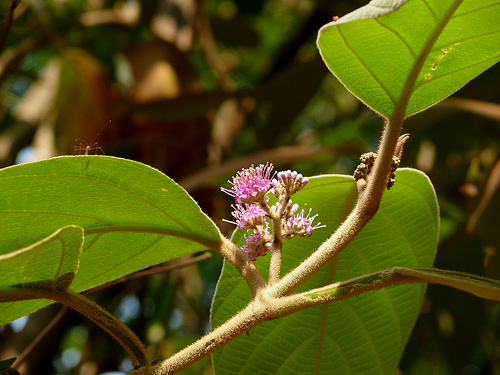 |
|
http://flickr.com/photos/91314344@N00 |
 |
| http://flickr.com/photos/himanshu_sarpotdar/ |
Translate this page:
Summary
Physical Characteristics

 Callicarpa macrophylla is a deciduous Shrub growing to 2.5 m (8ft 2in).
Callicarpa macrophylla is a deciduous Shrub growing to 2.5 m (8ft 2in).
See above for USDA hardiness. It is hardy to UK zone 9. It is in flower from June to October, and the seeds ripen from August to October. The species is hermaphrodite (has both male and female organs).
Suitable for: light (sandy), medium (loamy) and heavy (clay) soils and prefers well-drained soil. Suitable pH: mildly acid, neutral and basic (mildly alkaline) soils. It can grow in semi-shade (light woodland) or no shade. It prefers moist soil.
UK Hardiness Map
US Hardiness Map
Synonyms
Plant Habitats
Woodland Garden Dappled Shade;
Edible Uses
Edible Parts: Fruit
Edible Uses:
Fruit - raw. The white spongy fruit is sweet and succulent when fully ripe[272]
References More on Edible Uses
Medicinal Uses
Plants For A Future can not take any responsibility for any adverse effects from the use of plants. Always seek advice from a professional before using a plant medicinally.
Antirheumatic Aromatic Dysentery Poultice Stomachic
The leaves are heated and applied as a poultice to ease the pain of rheumatic joints[240, 272]. A decoction of the leaves is used in the treatment of diarrhoea and dysentery[272]. A juice made from the leaves mixed with equal portions of Drymaria diandra and Oxalis corniculata is used in the treatment of gastric troubles[272]. The root is chewed to relieve rashes on the tongue[272]. A paste made from the roots is used to treat fevers[272]. The juice of the root is used to treat indigestion[272]. An oil obtained from the roots is aromatic and stomachic[240]. It is assumed that this is an essential oil[K]. The inner bark is pounded and used as a poultice on cuts and wounds[272]. The fruits are chewed to treat boils on the tongue[272]. The juice of ripe fruits is used in the treatment of indigestion and fevers[272].
References More on Medicinal Uses
The Bookshop: Edible Plant Books
Our Latest books on Perennial Plants For Food Forests and Permaculture Gardens in paperback or digital formats.

Edible Tropical Plants
Food Forest Plants for Hotter Conditions: 250+ Plants For Tropical Food Forests & Permaculture Gardens.
More

Edible Temperate Plants
Plants for Your Food Forest: 500 Plants for Temperate Food Forests & Permaculture Gardens.
More

More Books
PFAF have eight books available in paperback and digital formats. Browse the shop for more information.
Shop Now
Other Uses
Wood
Wood - soft[158]. It is used as a fuel[272].
Special Uses
References More on Other Uses
Cultivation details
Requires a sunny position or light dappled shade[11, 200]. Prefers a highly fertile well-drained loamy soil[11, 200]. This species is only likely to be hardy in the very mildest parts of Britain, requiring a warm sunny corner[11, 182]. Requires cross-pollination for good fruit production[182]. Plants in this genus are notably resistant to honey fungus[200].
References Carbon Farming Information and Carbon Sequestration Information
Temperature Converter
Type a value in the Celsius field to convert the value to Fahrenheit:
Fahrenheit:
The PFAF Bookshop
Plants For A Future have a number of books available in paperback and digital form. Book titles include Edible Plants, Edible Perennials, Edible Trees,Edible Shrubs, Woodland Gardening, and Temperate Food Forest Plants. Our new book is Food Forest Plants For Hotter Conditions (Tropical and Sub-Tropical).
Shop Now
Plant Propagation
Seed - sow February in a greenhouse[78]. Only just cover the seed[138]. Germination usually takes place within 1 - 3 months at 18°c[138]. When large enough to handle, prick the seedlings out into individual pots and grow them on in the greenhouse for at least their first winter, planting them out into their permanent positions in late spring or early summer, after the last expected frosts. Cuttings of half-ripe wood 10cm long, July/August in a frame. High percentage[78]. Cuttings of mature wood of the current season's growth with a heel[78] taken in early spring[200].
Other Names
If available other names are mentioned here
Native Range
TEMPERATE ASIA: China (Guangdong Sheng, Guangxi Zhuangzu Zizhiqu, Guizhou Sheng, Yunnan Sheng) TROPICAL ASIA: Bhutan, India, Sri Lanka, Nepal, Myanmar, Thailand, Vietnam
Weed Potential
Right plant wrong place. We are currently updating this section.
Please note that a plant may be invasive in one area but may not in your area so it's worth checking.
Conservation Status
IUCN Red List of Threatened Plants Status :

Growth: S = slow M = medium F = fast. Soil: L = light (sandy) M = medium H = heavy (clay). pH: A = acid N = neutral B = basic (alkaline). Shade: F = full shade S = semi-shade N = no shade. Moisture: D = dry M = Moist We = wet Wa = water.
Now available:
Food Forest Plants for Mediterranean Conditions
350+ Perennial Plants For Mediterranean and Drier Food Forests and Permaculture Gardens.
[Paperback and eBook]
This is the third in Plants For A Future's series of plant guides for food forests tailored to
specific climate zones. Following volumes on temperate and tropical ecosystems, this book focuses
on species suited to Mediterranean conditions—regions with hot, dry summers and cool, wet winters,
often facing the added challenge of climate change.
Read More
Expert comment
Author
Vahl.
Botanical References
200266
Links / References
For a list of references used on this page please go here
Readers comment
© 2010, Plants For A Future. Plants For A Future is a charitable company limited by guarantee, registered in England and Wales. Charity No. 1057719, Company No. 3204567.